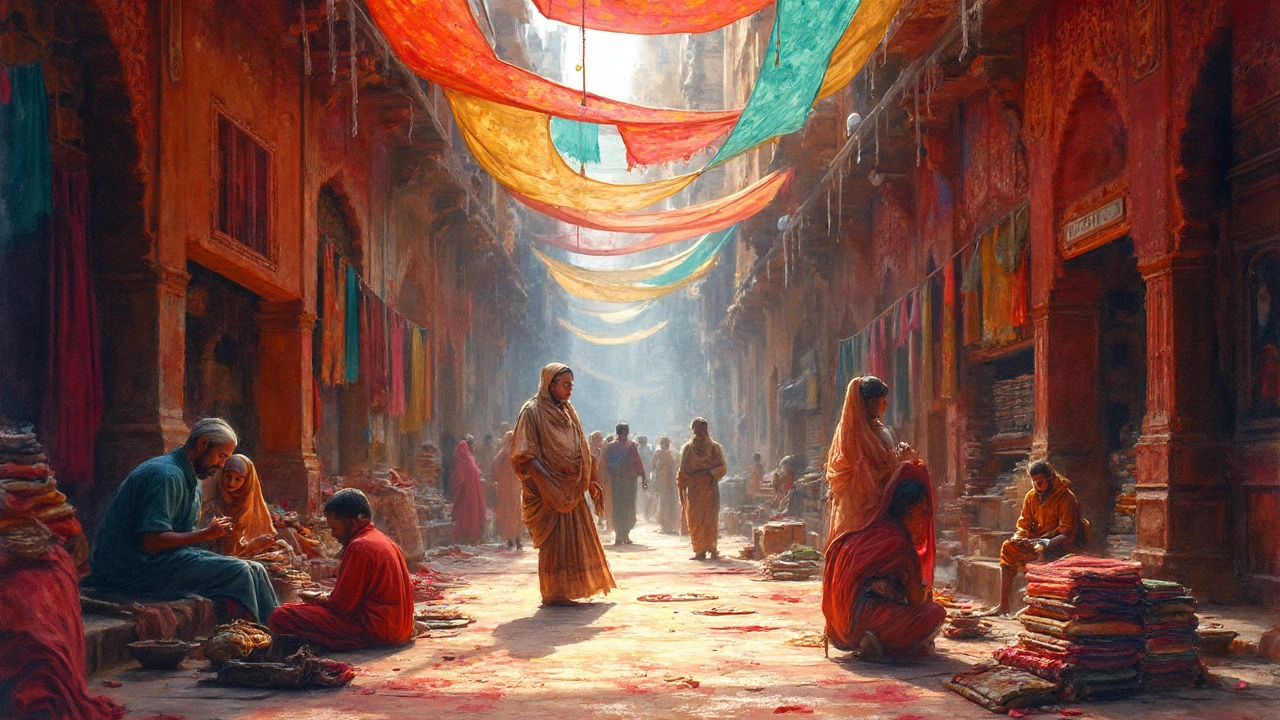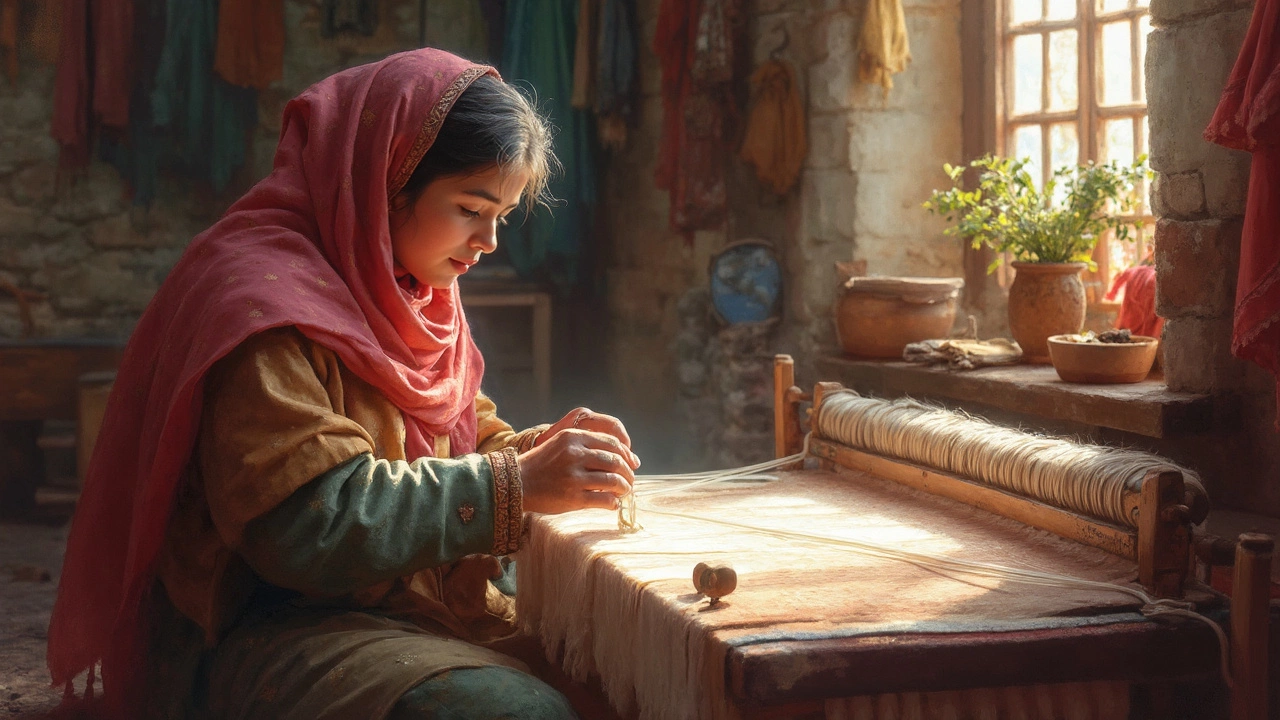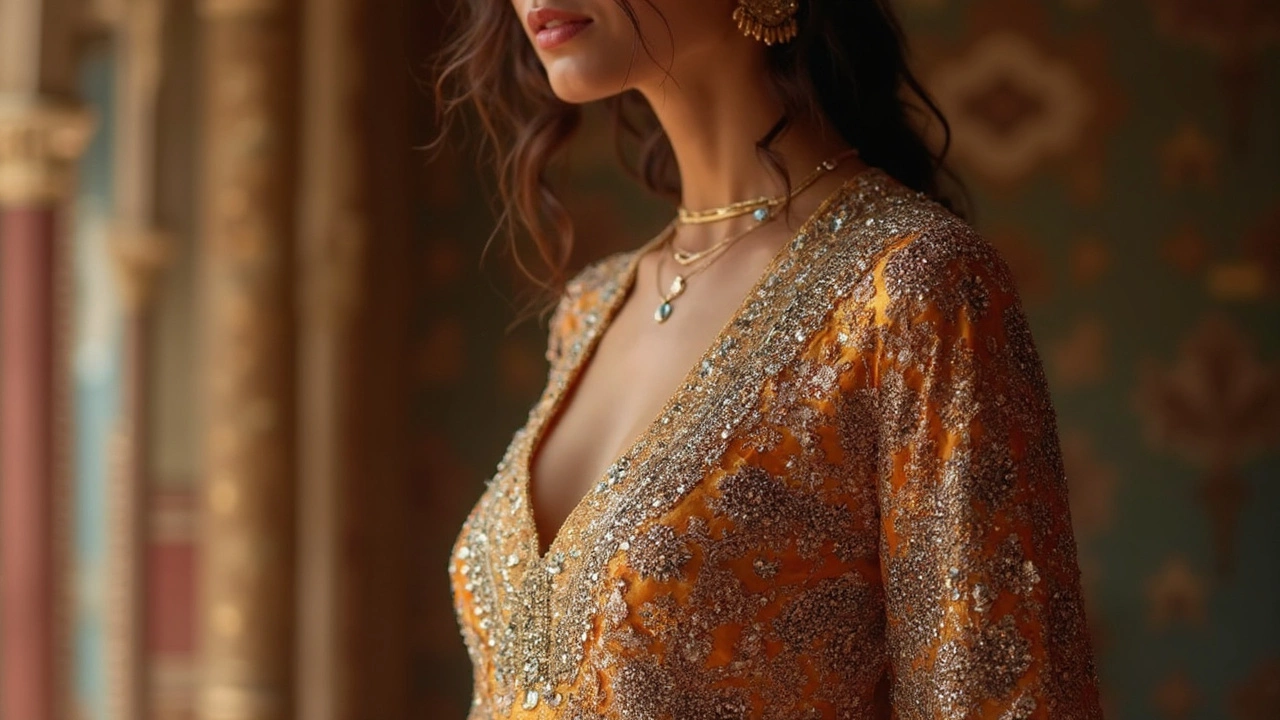 Mar, 28 2025
Mar, 28 2025
When it comes to luxury textiles, India is a treasure trove of some of the world's most sought-after fabrics. If you've ever wondered why certain Indian textiles carry such a high price tag, the answer lies in a mix of tradition, craftsmanship, and quality materials.
Take silk, for instance. Often dubbed the 'Queen of Fabrics', silk production in India is a labor-intensive process. The threads are painstakingly spun and woven to create a fabric that's not just shiny but also incredibly soft and durable. Silk sari from regions like Varanasi can take months to complete, with artisans carefully weaving intricate patterns and designs that reflect centuries of tradition.
Moving from silk to another gem, Banarasi silk is globally admired and often associated with opulence. Its grandeur comes from its complex weaving process, often embellished with gold and silver threads, making it a popular choice at weddings and special occasions. The richness of its texture and the story woven into every inch of fabric holds a significant place in Indian culture.
- Understanding the Value
- Silk: The Queen of Fabrics
- Masterful Weaving of Banarasi Silk
- Pashmina: The Soft Gold
- Other Expensive Textiles
Understanding the Value
Ever wonder why certain fabrics fetch a high price? The answer lies in more than just the material. It's about tradition, craftsmanship, and the intricate process each piece undergoes before hitting the market. In India, luxury textiles are not just fabrics; they are a representation of cultural heritage, artistry, and dedication.
When discussing the expensive fabrics of India, several factors determine their value. Firstly, the material itself is significant. High-quality silk, like that used in Banarasi or Kanchipuram saris, is a natural fiber that requires careful tending of silkworms. The texture, sheen, and soft drape are unparalleled, making silk a highly desired material.
Next, consider the time and skill invested in these garments. Many processes are incredibly labor-intensive, involving skilled artisans who sometimes spend months producing a single garment. This labor cost directly impacts the price of these textiles. The complexity of the patterns, often including motifs of flowers, animals, and traditional symbols, is a testament to the weaver's skill.
Additionally, the rarity and purity of the materials used add to the cost. Take Pashmina, often called the 'soft gold.' It's sourced from the Changthangi goat in the Himalayas, and the wool is collected once a year, rendered this fabric rare and precious.
To put it into perspective, compare the expenses involved. Here's a simplified look:
| Fabric | Material Cost (per meter) | Production Time | Value Added (Design Complexity) |
|---|---|---|---|
| Silk | £35 | 3-6 months | High |
| Banarasi Silk | £50 | Up to 12 months | Very High |
| Pashmina | £70 | Varies | Medium |
These figures illustrate the sheer effort and resources involved in crafting these masterpieces. So, the next time you see a luxurious Indian fabric, appreciate the journey it has undergone to become an expensive textile. It’s a story woven with every thread.
Silk: The Queen of Fabrics
Silk has long been a symbol of luxury and elegance, earning its title as the 'Queen of Fabrics.' In India, silk textiles are not just garments; they are pieces of art that carry the whispers of ancient traditions.
One of the remarkable things about silk is its production process. In India, it's primarily produced in states like Karnataka, Tamil Nadu, and Andhra Pradesh. Mulberry silk is most common, known for its fine texture and natural sheen. The transformation from cocoon to fabric is delicate and time-consuming, involving careful handling at every stage.
Have you ever wondered why silk saris are so prized? It's all in the detail. Artisans use a combination of handloom and power-loom techniques to achieve those elaborate patterns. The zari or gold thread work seen in many Indian saris adds an extra layer of glamor, reflecting light with every movement.
The appeal of silk extends beyond its lustrous look. It's highly breathable, has a natural temperature-regulating property, and feels luxurious against the skin. No wonder it's a preferred choice for weddings and special occasions.
Let's take a quick look at how India's silk industry is performing:
| State | Production (in tons) |
|---|---|
| Karnataka | 8,076 |
| Tamil Nadu | 1,042 |
| Andhra Pradesh | 4,015 |
The silk industry supports millions of livelihoods in India, from farmers rearing silkworms to weavers creating stunning designs. The effort and expertise involved in crafting these textiles justify their premium price. So, next time you see a silk sari, you're not just looking at fabric. You're witnessing centuries of craft and culture woven into every thread.

Masterful Weaving of Banarasi Silk
Banarasi silk is one of the most expensive fabrics in India, celebrated for its sumptuous texture and intricate designs. Originating from Varanasi, this silk has a centuries-old heritage that reflects a blend of cultures and craftsmanship techniques. The hallmark of Banarasi silk is its rich, intricate motifs, often inspired by Mughal art, depicting scenes of nature, florals, or temples.
Creating a Banarasi silk sari is no small feat. It can take anywhere from 15 days to 6 months to produce a single piece, depending on the complexity of the design. The artisans—referred to as 'kadhai karigars'—carefully weave metallic threads called 'zari' into the silk to form elaborate patterns. These zari threads can occasionally contain silver or gold, adding not just value but a distinct shimmer that Banarasi silk is famed for.
The process of weaving Banarasi silk involves multiple stages:
- Design Creation: The design is first drafted on paper before it's transferred to a punched card, guiding the weaving process.
- Thread Preparation: Silk threads are dyed and spooled, often requiring multiple colors to create the desired effect.
- Warping: These threads are then arranged on a frame loom, setting up the base for weaving.
- Weaving: Using a traditional pit loom, the artisan begins weaving, carefully lifting and lowering warp threads to interweave the silk and zari threads.
The uniqueness of Banarasi silk comes from its ability to blend grandeur with tradition, making it hugely popular among those looking to make a statement on special occasions. The fabric is not just a drape; it's a story of heritage, skill, and timeless beauty, making it well worth its high price tag.
Here's a quick look at Banarasi silk's global reach:
| Market | Export Volume (2023) | Growth Rate |
|---|---|---|
| United States | 500,000 meters | 15% |
| United Kingdom | 350,000 meters | 10% |
| UAE | 300,000 meters | 12% |
Pashmina: The Soft Gold
Ever heard of Pashmina? Often called the 'Soft Gold', this luxurious fabric is renowned for its warmth and exceptional softness. Originating from the high altitudes of the Himalayas, Pashmina is made from the fine hair of Changthangi goats. These goats live in cold climates, which is why their wool is so special.
Pashmina is not just about the raw material; it’s about the skillful craftsmanship too. The traditional process of making a Pashmina shawl involves meticulous hand-weaving, which can take up to 180 hours for a single piece. Each shawl is a testament to the artisans' dedication and skill.
One main reason why Pashmina is expensive in India is because of its rarity. Not every region has access to Changthangi goats, and the delicate process of hand-weaving makes the production quite limited. This scarcity, combined with the luxurious feel of the fabric, catapults Pashmina into the realm of luxury textiles.
- Quality Check: Authentic Pashmina can easily pass through a ring due to its fine fibers. A simple quality check often includes this 'ring test'.
- Softness & Warmth: Despite being so light, Pashmina is incredibly warm, making it a perfect choice for winter wear.
- Styling: It easily adapts to various styles—from traditional to Western outfits—which adds to its popularity across different cultures.
Buyers need to be cautious, though. The market is flooded with fake variants, often made of synthetic blends. A genuine Pashmina is usually higher-priced, but its quality is absolutely unmatched.

Other Expensive Textiles
Besides silk and Pashmina, India offers a range of luxury textiles that come with a hefty price tag. These textiles not only reflect the diverse cultural heritage of India but also the incredible effort and skill put into their creation.
One such fabric is Zari. Known for its metallic embroidery, Zari work is often done with gold or silver threads, adding a glorious shimmer to garments. This technique, rooted in Persian traditions, has been an integral part of Indian textile artistry for centuries. While Zari's intricate designs adorn sarees, lehengas, and even modern attire, the cost of the precious metals used makes it quite an expensive fabric.
Another noteworthy mention is Chanderi, predominantly produced in Madhya Pradesh. This sheer fabric, often a blend of silk, cotton, and zari, is known for its soft texture and light weight. The motifs on Chanderi are usually inspired by traditional coins, flowers, and peacocks, crafted with meticulous detail. Consumers are willing to shell out more for Chanderi because of its distinct feel and the age-old weaving tradition it represents.
Then there's the unique appeal of Brocade. Particularly popular in the regions of Gujarat and Uttar Pradesh, Brocade is a rich woven fabric with elaborate patterns. The combination of silk and metallic threads in Brocade is what makes it stand out, used extensively for grand occasions where making a statement is key.
Here's a quick look at some of these elite textiles:
- Zari: Known for metallic threadwork using gold and silver.
- Chanderi: Lightweight and sheer, often mixing silk, cotton, and zari.
- Brocade: Features rich patterns with silk and metallic threads.
Investing in these fabrics is not just about acquiring a piece of clothing; it's about owning a slice of India's rich textile history. Whether you're drawn to the sparkle of Zari or the elegance of Chanderi, these textiles offer something truly special for those willing to invest.